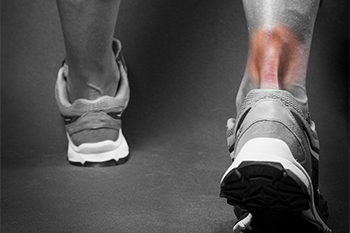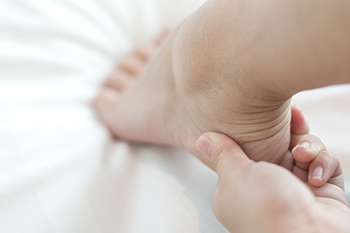 The foot is made up of 26 bones, any of which could potentially fracture or break. Stress fractures are tiny cracks in a bone caused by repetitive and excessive pressure on the foot. They are particularly common among athletes. The most commonly fractured foot bones are the metatarsals, located at the front of the foot, and the heel bone, or the navicular bone, located in the middle of the foot. Symptoms of a stress fracture include pain at the site of the fracture that worsens with activity and gradually increases over time, and swelling and tenderness of the surrounding area. Treatments include resting, icing, and elevating the affected foot, taking medications to relieve pain, and wearing a brace or other orthotic device to take pressure off the bone while it heals. Severe cases may warrant surgical intervention. If you believe that you may have fractured a foot bone, please consult with a chiropodist.
The foot is made up of 26 bones, any of which could potentially fracture or break. Stress fractures are tiny cracks in a bone caused by repetitive and excessive pressure on the foot. They are particularly common among athletes. The most commonly fractured foot bones are the metatarsals, located at the front of the foot, and the heel bone, or the navicular bone, located in the middle of the foot. Symptoms of a stress fracture include pain at the site of the fracture that worsens with activity and gradually increases over time, and swelling and tenderness of the surrounding area. Treatments include resting, icing, and elevating the affected foot, taking medications to relieve pain, and wearing a brace or other orthotic device to take pressure off the bone while it heals. Severe cases may warrant surgical intervention. If you believe that you may have fractured a foot bone, please consult with a chiropodist.
A foot fracture is a crack or break in a foot bone, often caused by repetitive stress on the foot or a high-impact foot injury. If you’re suffering from foot pain, please consult with one of the chiropodists from The Footcare Centre. Our chiropodists can help you maintain the health of your lower limbs and your mobility.
Symptoms
Pain
Bruising
Tenderness
Swelling
Difficulty walking
Deformity
Causes
Repetitive overloading of the foot
Having a previous fracture
Abnormal foot biomechanics
Changing training surfaces suddenly
Poor footwear
Osteoporosis
High-impact injury
Treatments
Rest
Ice
Elevation
Pain medication
Braces or other orthotics
Casts
Crutches
Surgery in more severe cases
If you have any questions, please feel free to contact our office located in . We offer the newest diagnostic and treatment technologies for all your foot care needs.


 Sever’s disease
Sever’s disease

